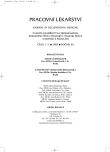-
Medical journals
- Career
Hyperbaric Oxygenotherapy in Treatment of Children with Neuroblastoma of Highest Risk: Experience in 1997–2000
Authors: P. Došel 1; M. Sázel 1; J. Staňková 2; P. Kavan 2; H. Křížová 2; P. Gajdoš 3
Authors‘ workplace: Ústav leteckého zdravotnictví Praha, ředitel MUDr. Dušan Bartoš, CSc. 1; Klinika dětské onkologie FN Motol a 2. LF UK v Praze, přednosta Prof. MUDr. Jan Starý, DrSc. 2; Klinika nukleární medicíny FN Motol a 2. LF UK v Praze, přednosta Doc. MUDr. Petr Vlček, CSc. 3
Published in: Pracov. Lék., 59, 2007, No. 1-2, s. 5-8.
Category: Original Papers
Overview
Treatment of highest risk neuroblastoma is problematic. 5 years overall survival is about 20%. Prognosis can be improved by administration of 131I MIBG. The advantage of this targeted tumour specific radiotherapy is the possibility of achievement 5–10 fold higher dose in comparison with external irradiation with less organ toxicity. 14 131I MIBG treatment applications were done in 7 patients with highest risk neuroblastoma in this period. Four children were given one administration, three children were given repetitive administrations. Out of these seven patients, three survived longer. 5.5 GBq was given within the first administration, 3.7 GBq in subsequent courses, irrespective of body weight, always followed by four days 100 minutes lasting hyperbaric oxygen therapy. Immediate tolerance of treatment was good. 131I MIBG treatment is well tolerated targeted irradiation enhanced by hyperbaric oxygen therapy.
Key words:
neuroblastoma, MIBG, hyperbaric oxygen therapy
Sources
1. VOUTE, P. A., KRAKER DE, J., HOEFNAGEL, C. A. Tumours of the Sympathetic Nervous System: Neuroblastoma, Ganglioneuroma and Phacochromocytoma. In Cancer in Children. Clinical Management. 3rd edition. Eds. P. A. Voute, A. Barrett, J. Lemerle. Heidelberg : Spinger Verlag 1992.
2. BRODCUR, G. M., PRITCHARD, J., BERTOLD, F., CARLSEN, N. L., CASTEL, V. CASTLEBERRY, R. P. et al. Revisions of international criteria for neuroblastoma diagnosis, staging and response to treatment. J. Clin. Oncol., 1993, 11, s. 1466–1477.
3. GRAY, L. H., CONGER, A. D., EBERT, M., HORNSEY S., SCOTT O. C. A. The concentration of oxygen dissolved in tissues at the time of irradiation as a factor in radiotherapy. B. J. Radiol., 1953, 26, s. 638–648.
4. FUJIMURA, F. Experimental studies on radiations effects under high oxygen pressure. J. Osaka Dent. Univ., 1974, 19, s. 100–108.
5. HENK, J. H., SMITH, C., W. Radiotherapy and hyperbaric oxygen in head and neck cancer. Lancet, 1977, 2, 4, s.105.
6. NIAS, A., H., W. The oxygen problem in radiotherapy. In Colin, B. Seymour, Carmel, Mothersill (eds.) New Developments in Fundamental and Applied Radiobiology. Taylor & Francis Ltd. 4 Fohn St. London WCIN 2ET, 1991 s. 318–327.
Labels
Hygiene and epidemiology Hyperbaric medicine Occupational medicine
Article was published inOccupational Medicine

2007 Issue 1-2-
All articles in this issue
- Hyperbaric Oxygenotherapy in Treatment of Children with Neuroblastoma of Highest Risk: Experience in 1997–2000
- Hyperbaric Oxygenotherapy in Traumatology: Therapeutic Results in 2005
- Contribution of Hyperbaric Oxygenotherapy in Comprehensive Therapy of Various Etiology Hypoxic Brain Affections in Children and Adults
- Monitoring of Heart Rate during the Training of Divers
- The Beginning of Hyperbaric Medicine and Oxygenotherapy Specialization in the Czech Republic and its Role in Current Human Medicine
- Hyperbaric Oxygen and Diabetic Foot
- Problem of Sudeck Syndrome
- Transcutaneous Oximetry
- Importance of Hyperbaric Oxygenotherapy in Treatment of Not Healing Defects
- Medical Aspects of Diving
- Medical Examinations of Divers
- Foramen Ovale Patent and Diving
- Occupational Medicine
- Journal archive
- Current issue
- Online only
- About the journal
Most read in this issue- Problem of Sudeck Syndrome
- Contribution of Hyperbaric Oxygenotherapy in Comprehensive Therapy of Various Etiology Hypoxic Brain Affections in Children and Adults
- Medical Examinations of Divers
- Transcutaneous Oximetry
Login#ADS_BOTTOM_SCRIPTS#Forgotten passwordEnter the email address that you registered with. We will send you instructions on how to set a new password.
- Career

